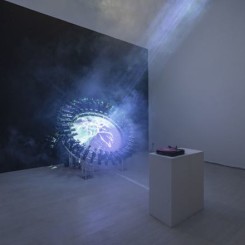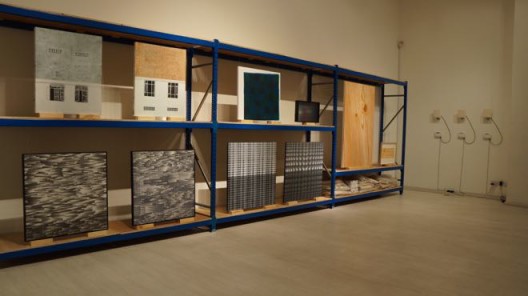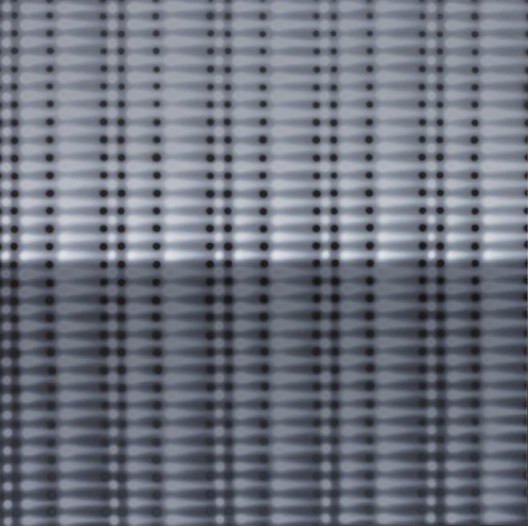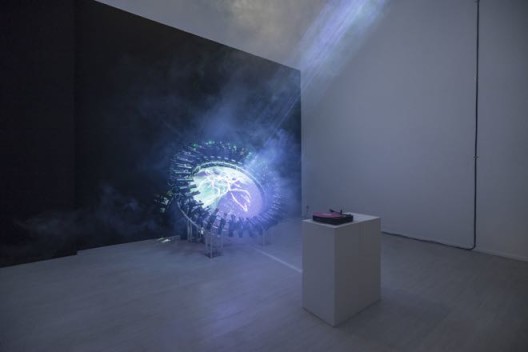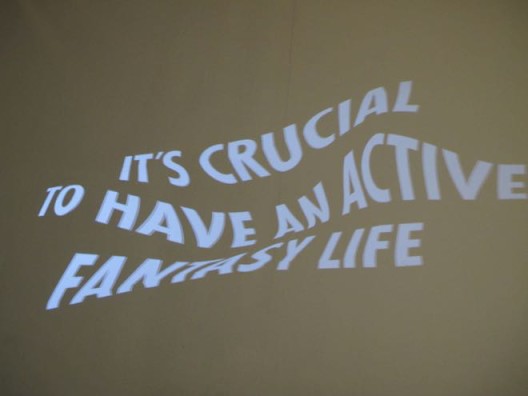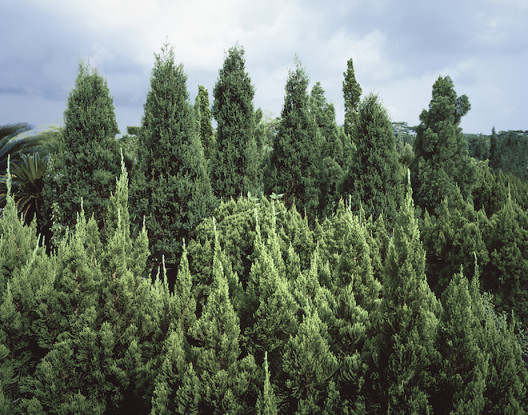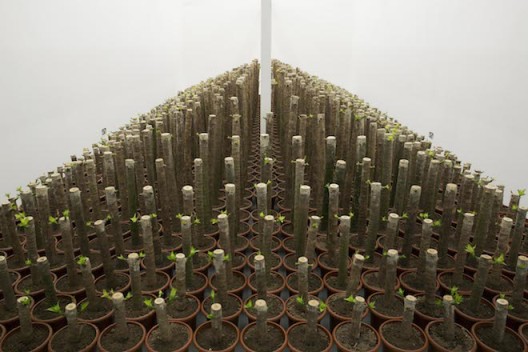Machine
Galerie Steph (39 Keppel Road #02-06), January 7 – February 17, 2015
Moving Light, Roving Sight
Ikkan Art International (39 Keppel Road #01-05), January 23 – February 18, 2015
A Tree With Too Many Branches
DECK (116 Prinsep Street), January 25 – March 15, 2015
To pick up where we left off with our post-Art Week round-up, while there has been a great heap of exhibitions and other events—the phrase “over a hundred” having been bandied about with some glee—a few things did stand out from the pack, and not just at Gillman Barracks.
Two of them are tucked away in a corner of an unassuming cargo distribution complex in the port district, both with a decidedly fitting technological-industrial bent: “Machine,” at Galerie Steph, by a group of young Chinese artists, and Ikkan Art International’s “Moving Light, Roving Sight” featuring, among others, teamLab and Jenny Holzer.
“Machine,” as its title baldly suggests, concerns itself with our relationship between ourselves and our almost wholly mechanized world. It is somewhat reminiscent of the New Aesthetic’s ruminations and experiments—though thankfully lacking in drone-panic or techno-utopianism—translated through relatively analogue modes of production: plenty of paintings, for one, and most of the works are mounted on an IKEA-esque shelving unit.
In their own ways, the paintings on show arguably depart from convention. At first glance, Li Shurui’s works appear no more than orderly, monochrome, airbrushed patterns, perhaps hinting at some process of mechanical production. But within moments they have a tendency to induce an eye-watering shimmer—something like a scintillating grid illusion hopped up on exotic pharmaceuticals. While optical illusions tend to offer little more than brief, confused amusement, Li’s “Home Made Series No. 4” (2014) seems more like taking sandpaper to your optic nerve. It’s a raw heightening of one’s awareness of vision that lays bare the fact that the whole phenomenon of vision is, so to speak, a mechanical system—and, like any such system, vulnerable to exploits.
On top of hacking our sense of vision, Machine also features a work which can only be fully observed through everyone’s favorite communicative prosthesis, the smartphone. Tao Hui’s “Emotional Manufacturing” (2011) is, to the naked eye, little more than three wifi routers and antennae—in sensory terms, possessed of an anodyne, manufactured seriality which befits functional electronic components. However, whipping out your phone to sniff for free wifi results in a barrage of textual abuse: the three networks are named, “You must be infected with HIV,” “Your mom is dead,” and “Your baby was raped.” It is an elevation of vulgar bathroom graffiti to some electronic ether which, despite apparently gleeful crudity, hints at the electronic extension of our senses—and, conversely, an intrusion of the electronic into our senses.
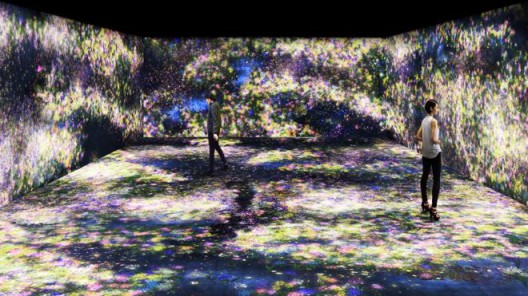
teamLab, “Flowers and People, Cannot be Controlled but Live Together-Dark”, 2015 (artist impression)
Ikkan Art International’s “Moving Light, Roving Sight,” on the other hand, takes a different route in being anchored by the work of collectives teamLab and invisible designs lab: respectively, “Flowers and People, Cannot be Controlled but Live Together—Dark” (2015) and ‘“TIME CORD” (CARNIVOROUS ROBOT eats SOUNDS and NOTES)’ (2015). Each, in their own way, presents an overwhelming technological spectacle: in the case of teamLab, being wholly immersed in a dazzling, all-around landscape of virtual flowers caught in a cycle of growing, blossoming, and withering. teamLab claims that each successive frame of the animation will never repeat a previous state—a cyclical, chaotic infinity to meditate upon or to be lost within.
As opposed to the landscape, invisible designs lab’s spectacle takes the monolithic form: an electro-mechanical juggernaut which bears a passing resemblance to the Large Hadron Collider. Instead of smashing hadrons together at mind-melting speeds, the installation’s centerpiece involves chimes and laser lights in a ring of articulated arms, surrounding a screen which displays pulsating, abstract polygons. All of this responds to input from a nearby record player, generating disquieting patterns of sound, light and motion; despite being very much a product of human agency—invisible designs lab’s condensation of the history and activity of the universe—its mechanical sophistication seems to harbor some cryptic potential to indifferently exceed its programmed parameters.
If there is a weakness to “Moving Light, Roving Sight,” it’s a tendency towards hyperbolic pomp, best seen in Naoko Tosa’s achingly relentless, exhaustingly luxurious slow-motion videos, which bear some resemblance to those bizarrely abstract video clips designed to showcase the technical capabilities of cutting-edge televisions. A possible antidote, if needed, might be Ang Song Nian’s “A Tree With Too Many Branches,” at DECK, a relatively new photography-focused space welded together out of cargo containers.
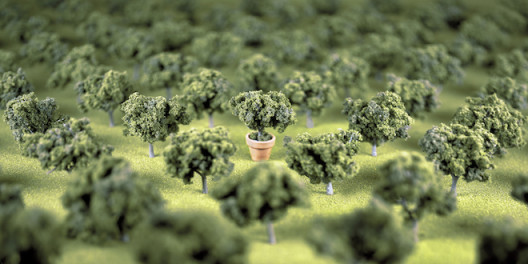
Ang Song Nian, On-site installation of “How The Forest Follows Me Around”, 2015. Photo by Marvin Tang
Ang’s work, as a counterpoint to industrial ephemerality of cargo containers, begins with a particular plant his father tended over the years, expanding into a general commentary on our relationship with the world of green and growing things. The show finds itself dispersed amongst these interconnected containers; fittingly enough, each space houses a distinctly different experience, the highlight of which is a wall-to-wall installation of eight hundred potted iron tree saplings (Dracaena fragrans ‘Massangeana’) in a pyramidal, rectilinear formation, suggesting some tension between the chaos of organic growth and development’s tendency to impose order on the world.
It’s a theme that’s also explored in the show’s other bodies of work, in particular the miniature photography of the series “The Perfect Pattern” (2015), in which tiny potted plants are set amidst a landscape of otherwise identical plants. As a whole, the show blends ruminations on the anthropocene with Ang’s personal memories, framing our reflections on our relationship with our biome in terms of Ang growing up with his father’s miniature garden. While not, at first glance, at the forefront of technology-driven changes in society—as with “Machine” and “Moving Light, Roving Sight”—nevertheless offers a restrained, reflective look at the very same, from a different point of view.
